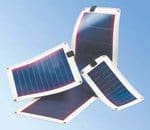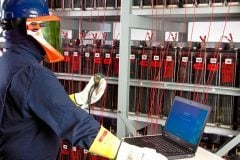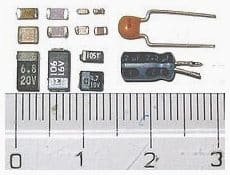There are three common technologies used in solar panels, all of which are based on the common element silicon, which makes up a large proportion of the earth.
Monocrystalline cells

Monocrystalline cells are made from a thin slice or wafer cut from a single large crystal of silicon. The cells are then doped and the fine current collecting wires printed on or in the surface of the cell.
Generally monocrystalline cells have the highest efficiency, but this comes at a price. This type of cell takes more energy to make than any other, and so has a greater energy payback period, though this is usually still within five years. A number of manufacturers make monocrystalline panels, including BP Solar and Sharp Solar.
Polycrystalline cells
 Polycrystalline cells are made from thin wafers of silicon cut from a large cast billet. The billet is not a large single crystal, but many crystals clumped together, hence the name.
Polycrystalline cells are made from thin wafers of silicon cut from a large cast billet. The billet is not a large single crystal, but many crystals clumped together, hence the name.
Polycrystalline cells are usually slightly less efficient than moncrystalline cells, but because they are square, can be fitted into the rectangular frame of a solar panel with high space efficiency, although polycrystalline panels are still slightly larger than monocrystalline panels of the same rating. Polycrystalline cells must also have current collecting grids printed onto them. Kyocera panels use this cell technology, as do many other panels.
Amorphous/thin film panels
 Amorphous/thin film panels involve deposition of very thin films of silicon or other materials directly onto a substrate such as glass or stainless steel. This technique produces a cell with a lower efficiency than the cut wafer varieties, but has the advantage of eliminating the need for inter-cell connections.
Amorphous/thin film panels involve deposition of very thin films of silicon or other materials directly onto a substrate such as glass or stainless steel. This technique produces a cell with a lower efficiency than the cut wafer varieties, but has the advantage of eliminating the need for inter-cell connections.
Uni-Solar makes triple junction, nine-layer thin-film amorphous panels with a much higher efficiency than the older types. The layers of silicon are deposited directly onto a stainless steel substrate and are then coated in a flexible plastic protective layer. There are now a number of manufacturers of thin-film panels, including Uni- Solar, Kaneka and Schott Solar.
Comparison
Panels made from polycrystalline cells are the most common and cheapest. (Typically BP, Solarex, Sharp and Kyocera). Their conversion efficiency 13% to 15% (sunlight to electricity). However, under elevated temperatures of 50° C panel temperature, the efficiency drops by around 20%.
Panels made from monocrystalline cells are used in high reliability applications such as telecommunications and remote power. (Typically BP, Siemens and ECO-CAMPER). Their conversion efficiency is typically 14-17.5% (higher than the polycrystalline cells). However, at elevated temp, the efficiency only drops by 10-15% so they are more consistent in output.
Panels made from amorphous cells have been used in portable items for many years (UniSolar). Their conversion efficiency of sunlight to electricity is 5-7%, about half that of the other panels but unlike the other types, their output does not decrease in elevated temperatures.
Panels made thin film cell CIGS technology. (Copper, Indium, Gallium, diSelenide) are flexible, durable, and provide slightly higher efficiency than other flexible solar cells. (SUNLINQ, Global Solar, P3). Typical sizes less than 60W.They can be mounted to curved surfaces and any backpack, tents or jackets.











There is a small mistake. Everybody always speak about Monocrystalline, Policrystalline … but, really, the word is Multicrystalline because Polycristalline cells have more smaller silicon grains. It is only a small detail.
You should add information about high-efficiency monocrystalline panels. SunPower, SpectroLab and Sanyo all have made panels that are more than 19% efficient, which would be good to add here.
Thanks for sharing with us!
Do you have some price comparison for above mentioned types of solar panels?
BR,